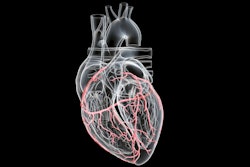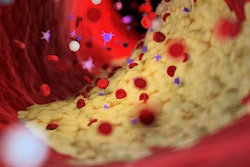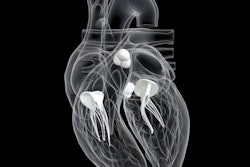A deep-learning algorithm could predict a patient’s risk of atherosclerotic cardiovascular disease (ASCVD) from analysis of noncontrast-enhanced chest CT exams, according to a study presented at the recent RSNA meeting.
Researchers, led by presenter Vineet Kalathur Raghu, PhD, from Harvard Medical School and Massachusetts General Hospital, trained an AI model to predict a patient’s probability of cardiovascular mortality within 12 years. In testing, the algorithm yielded a statistically significant improvement in prediction performance over a baseline regression model. The algorithm, called CT-CV-Risk, also predicted cardiovascular mortality beyond CAC and baseline risk factors, according to the researchers.
“We hope that this can help improve cardiovascular risk stratification to guide primary prevention,” Raghu told session attendees.
Coronary artery calcium (CAC) scoring on CT exams can be utilized to estimate the 10-year risk of ASCVD. In 2018, the American Heart Association and American College of Cardiology published cholesterol guidelines that recommend CAC scoring be used to guide decisions on whether adults with at an intermediate (7.5% to 20%) 10-year risk should take a statin.
Raghu's group, as well as other researchers, have previously demonstrated that convolutional neural networks (CNNs) can accurately measure CAC on noncontrast-enhanced chest CT scans, including low-dose lung cancer screening CT exams.
“This automated CAC score is highly correlated to manual CAC measurements and has similar value to predict future cardiovascular risk,” he said.
In the study, they sought to determine if AI could also extract information from CT to predict cardiovascular risk beyond the CAC score and beyond prevalent cardiovascular risk factors. The researchers trained two separate CNNs using 2D projections of CT volumes -- one for coronal images and one for axial images. Each model outputs an estimate of cardiovascular risk, which is then combined using a logistic regression model to produce a final 12-year risk score.
After training CT-CV-Risk using 10,151 CT exams from the National Lung Screening Trial (NLST), they then tested it on a holdout set of 6,745 individuals from the NLST. All patients with history of type 2 diabetes, myocardial infarction, or stroke were excluded from the study. The primary outcome was fatal cardiovascular events over 12 years of follow-up.
The researchers then compared the performance of the combined model with a baseline regression model that incorporated age, sex, body mass index (BMI), race, current smoking status, history of cancer, and CT findings into its analysis.
The best results were achieved when using results from both the regression model and the best AI model.
| Baseline regression model | Best AI model | Combination of baseline regression model and best AI model | |
| Cardiovascular mortality C-statistic | 0.69 | 0.69 | 0.72 |
| Fatal myocardial infarction C-statistic | 0.69 | 0.70 | 0.73 |
| Fatal stroke C-statistic | 0.68 | 0.69 | 0.73 |
All differences between the baseline regression model and the combination of the baseline regression model and the best AI model were statistically significant.
In a further subanalysis of 3,878 patients who had automatic CAC scores, a high CT-CV-Risk score and CAC scoring had a complementary, graded association with cardiovascular mortality risk, Raghu reported.
The team also noted that association analyses found that CT-CV-Risk scores from axial and coronal projections were most strongly associated with age, sex, BMI, history of myocardial infarction, and history of hypertension.
“A deep learning-based model can predict incident cardiovascular mortality beyond prevalent cardiovascular risk factors and CAC score,” Raghu said.
He acknowledged the limitations of their research, including its retrospective nature and the need for external validation. The group also aims to leverage information from the full 3D CT volumes in future work.




















